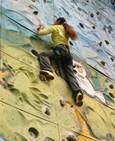题目内容
Parkour
The word “parkour” comes from a French phrase roughly translated as “military obstacle course(军事障碍课程).” At first glance parkour looks like an extreme sport, and it certainly has many of the same qualities of an extreme sport. However, it is considered by many tracers as more of an art and exercise, which allows for individual expression and also promotes inner strength and personal growth.
It introduces us to complete freedom from obstacles, and it is this freedom that makes parkour very appealing in strict control of modern society. It is a method that’s available to us at any time to deal with the obstacles facing us, both mental and physical. No obstacle, no barrier can stop the tracer;they continue moving forward in spite of, and in harmony with these.
While parkour does allow for a great deal of originality, there are certain methods commonly used when practicing it. The tracer chooses his/her own path through the environment to create unique and flowing movement, adapting to and using anything in this path. When many techniques or moves used to overcome obstacles are linked together in an efficient and continuous way, it is known as a “run.” If you see someone that looks like they’re running from the police, but there is no one running after, it’s probably parkour.
This idea of the chase represents and expresses the movement of parkour quite well. In fact, it is the form of movement that our ancient ancestors may have used to hunt for food, or escape from animals on the plains of Africa. In adapting instantly to whatever comes forth without thinking about it, we naturally flow over and around all obstacles. In practicing parkour, we are reviving and developing that ancient instinct(本能).
The attitude behind parkour also combines the mentality of a child at play. That unlimited imagination and energy combined with a complete ignoring of social practices epitomizes(成为…的缩影)the tracer. Others look at a rail or wall and see a barrier;we look at it and see a launch pad. And hey, let’s not forget that we do this because it’s fun! The world is our jungle gym, let’s go play!
1.The underlined word in paragraph 1 means
A.parkour participants B.fitness experts
C.sports psychologists D.extreme sports lovers
2.Paragraph 4 is written to .
A.show the way to develop ancient instinct
B.introduce the evolution of parkour
C.distinguish parkour from ancient instinct
D.explain the origin of parkour
3.What do we know about parkour according to the passage?
A.It is an activity dating back to ancient times.
B.People need to go past anything in the way while doing it.
C.It’s difficult to do without the aid of professional equipment.
D.People need military training before taking part in it.
4.People may show interest in parkour because .
A.they can get freed from routine activities and tasks
B.it helps them to do their job efficiently in future
C.they can develop both physically and mentally
D.it has its roots in their childhood experience
ADBC

 浙大优学小学年级衔接捷径浙江大学出版社系列答案
浙大优学小学年级衔接捷径浙江大学出版社系列答案 B.
B. 
 D.
D. 
 B.
B.

 D.
D. 
 B.
B. 
 D.
D. 